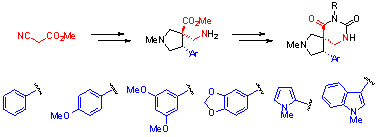Synthesis of Dihydrouracils Spiro-Fused to Pyrrolidines: Druglike Molecules Based on the 2-Arylethyl Amine Scaffold
Abstract
:1. Introduction

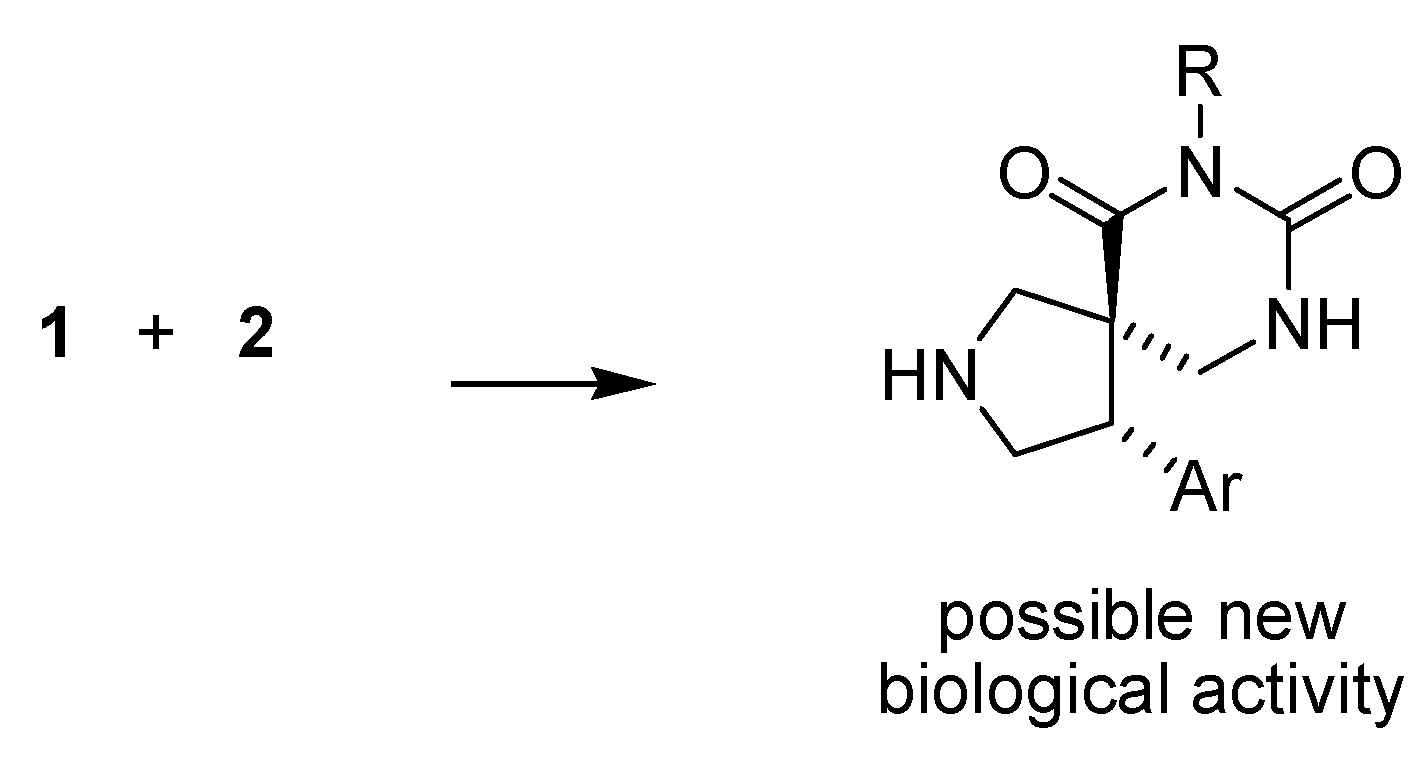
2. Results and Discussion

2.1. Knoevenagel condensation reaction

 | ||||
| Entry | ArCHO | Product | Time (min) | Yield (%) |
| 1 | 10{1} | 8{1} | 30 | 99 |
| 2 | 10{2} | 8{2} | 30 | 94 |
| 3 | 10{3} | 8{3} | 40 | 99 |
| 4 | 10{4} | 8{4} | 60 | 99 |
| 5 | 10{5} | 8{5} | 120 | 95 |
| 6 | 10{6} | 8{6} | 120 | 96 |
| 7 | 10{7} | 8{7} | 30 | 99 |
| 8 | 10{8} | 8{8} | 480a | 99 |
| 9 | 10{9} | 8{9} | 30 | 94 |
| 10 | 10{10} | 8{10} | 30 | 99 |
| 11 | 10{11} | 8{11} | 90 | 93 |
| 12 | 10{12} | 8{12} | 25 | 99 |
2.2. 1,3-Dipolar cycloaddition reaction
 | |||||
| Entry | Acrylate | Product(s)a | Time (min) | Yield (%) | |
| 1 | 8{1} | 7{1} | 20 | 94 | |
| 2 | 8{2} | 7{2} | 75 | 99 | |
| 3 | 8{3} | 7{3} | 80 | 95 | |
| 4 | 8{4} | 7{4} | 80 | 99 | |
| 5 | 8{5} | 7{5} | 120 | 52 | |
| 6 | 8{6} | 7{6} | 80 | 95 | |
| 7 | 8{7} | 7{7} | 240 | - | |
| 8 | 8{8} | 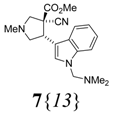 | 150 | 85 | |
| 9 | 8{9} | 7{9} + |  | 80 | 87b |
| 10 | 8{10} | 7{10} + |  | 45 | 90c |
| 11 | 8{11} | 7{11} + |  | 25 | 72d |
| 12 | 8{12} | 7{12} + |  | 45 | 85e |
2.3. Reduction
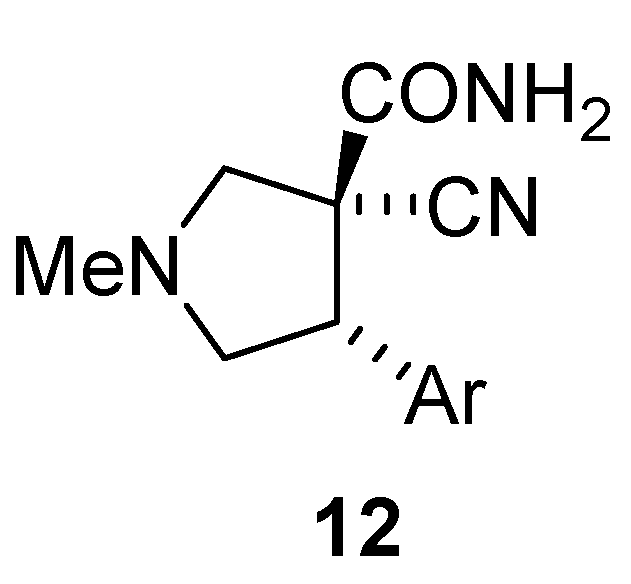
 | |||
| Entry | Substrate | Product | Yield (%) |
| 1 | 7{1} | 6{1} | 95 |
| 2 | 7{2} | 6{2} | 95 |
| 3 | 7{3} | 6{3} | 89 |
| 4 | 7{4} | 6{4} | 85 |
| 5 | 7{5} | 6{5} | 73 |
| 6 | 7{6} | 6{6} | 95 |
2.4. Parallel synthesis of spiro dihydrouracils
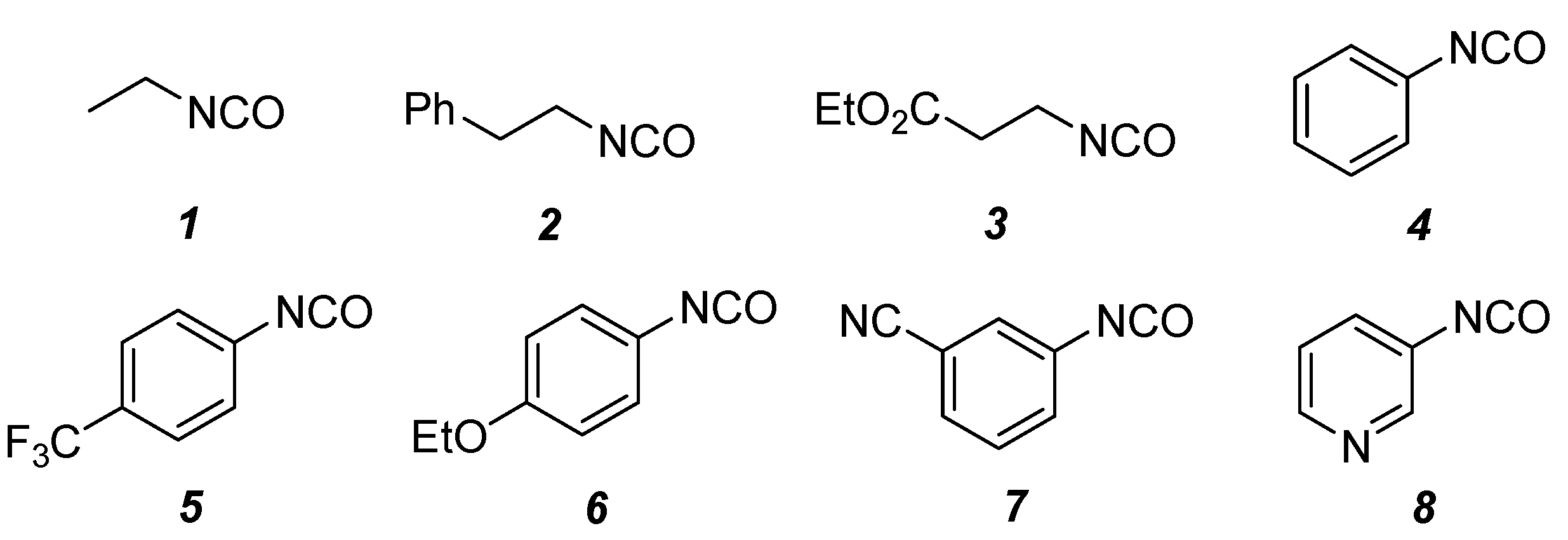




 |  |  |
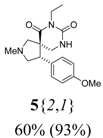 |  |  |
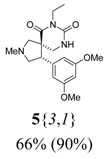 |  | 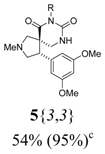 |
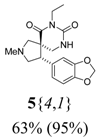 |  |  |
 |  |  |
 |  |  |
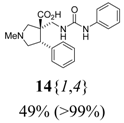 | 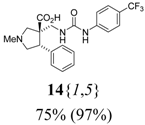 | 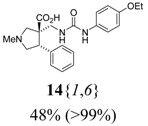 | 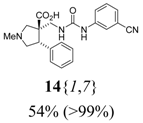 |  |
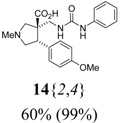 | 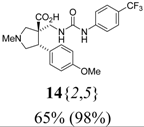 | 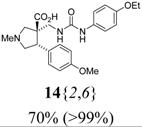 | 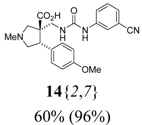 | 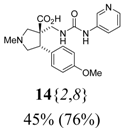 |
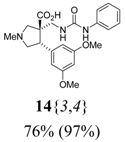 | 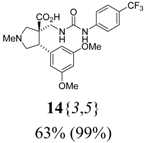 | 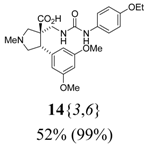 | 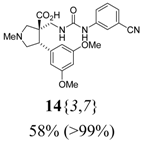 | 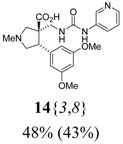 |
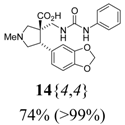 | 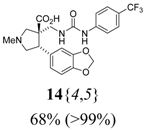 | 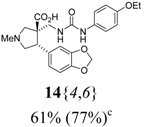 | 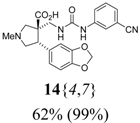 | 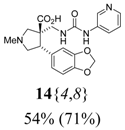 |
 | 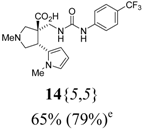 | 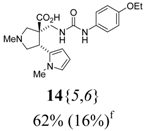 |  |  |
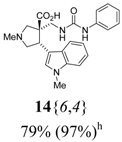 | 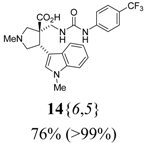 | 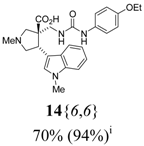 |  | 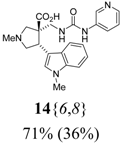 |
 | ||
| Entry | Conditions | Productsa 15{1,4}/5{1,4}/14{1,4} |
| 1 | Et3N (1.1 equiv), THF, Ar, reflux, 22 h | 1:0:0 |
| 2 | Proton sponge (0.2 equiv), THF, 21 °C, 5 h | 1:0:0 |
| 3 | Proton sponge (1 equiv), THF, 21 °C, 17 h | 1:0:0 |
| 4 | Proton sponge (1 equiv), THF, reflux, 7 h | 1:0:0 |
| 5 | DIPEA (1 equiv), DMF, 90 °C, 6 h | 1:0:0 |
| 6 | DBU (1 equiv), THF, Ar, 26 °C, 5 h | 1:0:0 |
| 7 | DBU (1 equiv), THF, Ar, reflux, 17 h | 5:1:0 |
| 8 | DBU (1 equiv), Bu4NBr, 4 Å MS, PhMe, Ar, reflux, 27 h | 1:9:0 |
| 9 | KOBut (1 equiv), THF, 29 °C, 30 min | 1:3:1 |
| 10 | KOBut (1 equiv), THF, 31 °C, 55 min | 0:2:1 |
| 11 | KOBut (1 equiv), THF, Ar, 21 °C, 2 h | 0:1:2 |
| 12 | KOBut (0.1 equiv), THF, Ar, 21 °C, 17 h | 3:6:1 |
| 13 | Phosphazene P2-t-Bu (0.1 equiv), THF, Ar, 21 °C, 5 h | 1:3:0 |
| 14 | Phosphazene P2-t-Bu (1 equiv), THF, Ar, 21 °C, 18 h | 1:0:4 |
| 15 | DMSO, 165 °C, 15 h | decomposition |
3. Experimental
3.1. General
3.2. General procedure for Knoevenagel condensation reaction
 (cm–1), neat]: 3036, 2954, 2224, 1727, 1606, 1200, 767, 685. Elem. anal. calcd. for C11H9NO2: C 70.58%, H 4.85%, N 7.48%; found C 70.39%, H 4.54%, N 7.43%. RF: 0.63 (heptane/AcOEt, 1:1). Mp: 87.9 °C (from MeOH, colorless flake-like crystals). Purity: >99.5% (GC).
(cm–1), neat]: 3036, 2954, 2224, 1727, 1606, 1200, 767, 685. Elem. anal. calcd. for C11H9NO2: C 70.58%, H 4.85%, N 7.48%; found C 70.39%, H 4.54%, N 7.43%. RF: 0.63 (heptane/AcOEt, 1:1). Mp: 87.9 °C (from MeOH, colorless flake-like crystals). Purity: >99.5% (GC). (cm–1), neat]: 3084, 2954, 2846, 2215, 1714, 1580, 1264, 1174, 841. Elem. anal. calcd. for C12H11NO3: C 66.35%, H 5.10%, N 6.45%; found C 66.24%, H 4.98%, N 6.33%. RF: 0.58 (heptane/AcOEt, 1:1). Mp: 104.1 °C (from MeOH, off-white small crystals). Purity: >99.5% (GC).
(cm–1), neat]: 3084, 2954, 2846, 2215, 1714, 1580, 1264, 1174, 841. Elem. anal. calcd. for C12H11NO3: C 66.35%, H 5.10%, N 6.45%; found C 66.24%, H 4.98%, N 6.33%. RF: 0.58 (heptane/AcOEt, 1:1). Mp: 104.1 °C (from MeOH, off-white small crystals). Purity: >99.5% (GC). (cm–1), neat]: 3086, 2940, 2841, 2217, 1723, 1604, 1247, 1167, 840. Elem. anal. calcd for C13H13NO4: C 63.15%, H 5.30%, N 5.66%; found C 63.22%, H 5.14%, N 5.53%. RF: 0.56 (heptane/AcOEt, 1:1). Mp: 121.5 °C (from MeOH, long light yellow needles). Purity: >99.5% (GC).
(cm–1), neat]: 3086, 2940, 2841, 2217, 1723, 1604, 1247, 1167, 840. Elem. anal. calcd for C13H13NO4: C 63.15%, H 5.30%, N 5.66%; found C 63.22%, H 5.14%, N 5.53%. RF: 0.56 (heptane/AcOEt, 1:1). Mp: 121.5 °C (from MeOH, long light yellow needles). Purity: >99.5% (GC). (cm–1), neat]: 3029, 2957, 2218, 1723, 1579, 1244, 1205, 1041, 922, 819. HRMS [EI (m/z)] calcd for C12H9NO4 = 231.0532, found for [M+•] = 231.0532 (|Δ| = 0.0 ppm), peaks at (relative intensity): 231 (100), 200 (21), 170 (32), 142 (12), 114 (21). Elem. anal. calcd for C12H9NO4: C 62.34%, H 3.92%, N 6.06%; found C 62.24%, H 3.86%, N 6.00%. RF: 0.60 (heptane/AcOEt, 1:1). Mp: 169.6 °C (from MeOH, light green cotton-like solid). Purity: >99.5% (GC).
(cm–1), neat]: 3029, 2957, 2218, 1723, 1579, 1244, 1205, 1041, 922, 819. HRMS [EI (m/z)] calcd for C12H9NO4 = 231.0532, found for [M+•] = 231.0532 (|Δ| = 0.0 ppm), peaks at (relative intensity): 231 (100), 200 (21), 170 (32), 142 (12), 114 (21). Elem. anal. calcd for C12H9NO4: C 62.34%, H 3.92%, N 6.06%; found C 62.24%, H 3.86%, N 6.00%. RF: 0.60 (heptane/AcOEt, 1:1). Mp: 169.6 °C (from MeOH, light green cotton-like solid). Purity: >99.5% (GC). (cm–1), neat]: 3120, 2957, 2899, 2210, 1717, 1591, 1243, 748. Elem. anal. calcd for C10H10N2O2: C 63.15%, H 5.30%, N 14.73%; found C 63.19%, H 5.09%, N 14.70%. RF: 0.29 (heptane/AcOEt, 1:1). Mp: 154.2 °C (from MeOH, yellow solid). Purity: >99.5% (GC).
(cm–1), neat]: 3120, 2957, 2899, 2210, 1717, 1591, 1243, 748. Elem. anal. calcd for C10H10N2O2: C 63.15%, H 5.30%, N 14.73%; found C 63.19%, H 5.09%, N 14.70%. RF: 0.29 (heptane/AcOEt, 1:1). Mp: 154.2 °C (from MeOH, yellow solid). Purity: >99.5% (GC). (cm–1), neat]: 3118, 3026, 2950, 2222, 1701, 1586, 1255, 751. HRMS [EI (m/z)] calcd for C14H12N2O2 = 240.0899, found for [M+•] = 240.0895 (|Δ| = 1.6 ppm), peaks at (relative intensity): 240 (100), 209 (53), 140 (18), 49 (12). Elem. anal. calcd for C14H12N2O2: C 69.99%, H 5.03%, N 11.66%; found C 69.69%, H 4.85%, N 11.42%. RF: 0.37 (heptane/AcOEt, 1:1). Mp: 165.9 °C (from MeOH, yellow solid). Purity: >99.5% (GC).
(cm–1), neat]: 3118, 3026, 2950, 2222, 1701, 1586, 1255, 751. HRMS [EI (m/z)] calcd for C14H12N2O2 = 240.0899, found for [M+•] = 240.0895 (|Δ| = 1.6 ppm), peaks at (relative intensity): 240 (100), 209 (53), 140 (18), 49 (12). Elem. anal. calcd for C14H12N2O2: C 69.99%, H 5.03%, N 11.66%; found C 69.69%, H 4.85%, N 11.42%. RF: 0.37 (heptane/AcOEt, 1:1). Mp: 165.9 °C (from MeOH, yellow solid). Purity: >99.5% (GC). (cm–1), neat]: 3300, 3032, 2950, 2215, 1692, 1593, 1221, 750. Elem. anal. calcd for C9H8N2O2: C 61.36%, H 4.58%, N 15.90%; found C 61.45%, H 4.58%, N 15.79%. RF: 0.37 (heptane/AcOEt, 1:1). Mp: 140.2 °C (from MeOH, small thin yellow needles). Purity: >99.5% (GC).
(cm–1), neat]: 3300, 3032, 2950, 2215, 1692, 1593, 1221, 750. Elem. anal. calcd for C9H8N2O2: C 61.36%, H 4.58%, N 15.90%; found C 61.45%, H 4.58%, N 15.79%. RF: 0.37 (heptane/AcOEt, 1:1). Mp: 140.2 °C (from MeOH, small thin yellow needles). Purity: >99.5% (GC). (cm–1), neat]: 3266, 3132, 2989, 2943, 2212, 1695, 1589, 1241, 742. Elem. anal. calcd for C13H10N2O2: C 69.02%, H 4.46%, N 12.38%; found C 68.97%, H 4.38%, N 12.22%. RF: 0.80 (AcOEt). Mp: 189.5 °C (from MeOH, yellow needles). Purity: >99.5% (GC).
(cm–1), neat]: 3266, 3132, 2989, 2943, 2212, 1695, 1589, 1241, 742. Elem. anal. calcd for C13H10N2O2: C 69.02%, H 4.46%, N 12.38%; found C 68.97%, H 4.38%, N 12.22%. RF: 0.80 (AcOEt). Mp: 189.5 °C (from MeOH, yellow needles). Purity: >99.5% (GC). (cm–1), neat]: 3087, 3028, 2964, 2216, 1718, 1590, 1271, 1214, 729. Elem. anal. calcd for C9H7NO2S: C 55.94%, H 3.65%, N 7.25%; found C 55.98%, H 3.63%, N 7.23%. RF: 0.61 (heptane/AcOEt, 1:1). Mp: 106.9 °C (from MeOH, light brown needles). Purity: >99.5% (GC).
(cm–1), neat]: 3087, 3028, 2964, 2216, 1718, 1590, 1271, 1214, 729. Elem. anal. calcd for C9H7NO2S: C 55.94%, H 3.65%, N 7.25%; found C 55.98%, H 3.63%, N 7.23%. RF: 0.61 (heptane/AcOEt, 1:1). Mp: 106.9 °C (from MeOH, light brown needles). Purity: >99.5% (GC). (cm–1), neat]: 3050, 2963, 2220, 1720, 1278, 1215, 781, 740. Elem. anal. calcd for C10H8N2O2: C 63.83%, H 4.28%, N 14.89%; found C 64.06%, H 4.26%, N 14.79%. RF: 0.34 (heptane/AcOEt, 1:1). Mp: 131.7 °C (from MeOH, small brown needles). Purity: >99.5% (GC).
(cm–1), neat]: 3050, 2963, 2220, 1720, 1278, 1215, 781, 740. Elem. anal. calcd for C10H8N2O2: C 63.83%, H 4.28%, N 14.89%; found C 64.06%, H 4.26%, N 14.79%. RF: 0.34 (heptane/AcOEt, 1:1). Mp: 131.7 °C (from MeOH, small brown needles). Purity: >99.5% (GC). (cm–1), neat]: 3031, 2959, 2223, 1722, 1280, 697. RF: 0.13 (heptane/AcOEt, 1:1). Mp: 129.2 °C.
(cm–1), neat]: 3031, 2959, 2223, 1722, 1280, 697. RF: 0.13 (heptane/AcOEt, 1:1). Mp: 129.2 °C. (cm–1), neat]: 3033, 2955, 2225, 1726, 1236, 1198, 818. Elem. anal. calcd for C10H8N2O2: C 63.83%, H 4.28%, N 14.89%; found C 63.94%, H 4.25%, N 14.75%. RF: 0.12 (heptane/AcOEt, 1:1). Mp: 126.6 °C (from MeOH, small pink needles). Purity: >99.5% (GC).
(cm–1), neat]: 3033, 2955, 2225, 1726, 1236, 1198, 818. Elem. anal. calcd for C10H8N2O2: C 63.83%, H 4.28%, N 14.89%; found C 63.94%, H 4.25%, N 14.75%. RF: 0.12 (heptane/AcOEt, 1:1). Mp: 126.6 °C (from MeOH, small pink needles). Purity: >99.5% (GC).3.3. General procedure for 1,3-dipolar cycloaddition reactions of 8
 (cm–1), neat]: 2950, 2846, 2790, 2241, 1740, 1247, 772, 699. MS [ESI (m/z)] calcd for (C14H16N2O2 + H)+ = 245, found 245. RF: 0.24 (heptane/AcOEt, 1:1). Mp: 53.3 °C (from heptane, colorless crystals). Purity: >99.5% (GC).
(cm–1), neat]: 2950, 2846, 2790, 2241, 1740, 1247, 772, 699. MS [ESI (m/z)] calcd for (C14H16N2O2 + H)+ = 245, found 245. RF: 0.24 (heptane/AcOEt, 1:1). Mp: 53.3 °C (from heptane, colorless crystals). Purity: >99.5% (GC). (cm–1), neat]: 2951, 2836, 2788, 2243, 1740, 1247, 832. MS [ESI (m/z)] calcd for (C15H18N2O3 + H)+ = 275, found 275. RF: 0.23 (heptane/AcOEt, 1:1). Purity: 98.9% (GC).
(cm–1), neat]: 2951, 2836, 2788, 2243, 1740, 1247, 832. MS [ESI (m/z)] calcd for (C15H18N2O3 + H)+ = 275, found 275. RF: 0.23 (heptane/AcOEt, 1:1). Purity: 98.9% (GC). (cm–1), neat]: 2948, 2837, 2790, 2243, 1743, 1595, 1203, 1155. HRMS [EI (m/z)] calcd for C16H20N2O4 = 304.1423, found for [M+•] = 304.1436 (|Δ| = 4.2 ppm), peaks at (relative intensity): 304 (16), 261 (18), 193 (11), 57 (100), 42 (20). Elem. anal. calcd for C16H20N2O4: C 63.14%, H 6.62%, N 9.20%; found C 63.33%, H 6.65%, N 9.19%. RF: 0.19 (heptane/AcOEt, 1:1). Mp: 94.7 °C (from heptane, colorless crystals). Purity: >99.5% (GC).
(cm–1), neat]: 2948, 2837, 2790, 2243, 1743, 1595, 1203, 1155. HRMS [EI (m/z)] calcd for C16H20N2O4 = 304.1423, found for [M+•] = 304.1436 (|Δ| = 4.2 ppm), peaks at (relative intensity): 304 (16), 261 (18), 193 (11), 57 (100), 42 (20). Elem. anal. calcd for C16H20N2O4: C 63.14%, H 6.62%, N 9.20%; found C 63.33%, H 6.65%, N 9.19%. RF: 0.19 (heptane/AcOEt, 1:1). Mp: 94.7 °C (from heptane, colorless crystals). Purity: >99.5% (GC). (cm–1), neat]: 2965, 2900, 2788, 2242, 1740, 1249, 1036, 929. HRMS [EI (m/z)] calcd for C15H16N2O4 = 288.1110, found for [M+•] = 288.1097 (|Δ| = 4.5 ppm), peaks at (relative intensity): 288 (13), 57 (100), 42 (11). Elem. anal. calcd for C15H16N2O4: C 62.49%, H 5.59%, N 9.72%; found C 62.56%, H 5.61%, N 9.69%. RF: 0.22 (heptane/AcOEt, 1:1). Mp: 87.6 °C (from heptane, colorless crystals). Purity: >99.5% (GC).
(cm–1), neat]: 2965, 2900, 2788, 2242, 1740, 1249, 1036, 929. HRMS [EI (m/z)] calcd for C15H16N2O4 = 288.1110, found for [M+•] = 288.1097 (|Δ| = 4.5 ppm), peaks at (relative intensity): 288 (13), 57 (100), 42 (11). Elem. anal. calcd for C15H16N2O4: C 62.49%, H 5.59%, N 9.72%; found C 62.56%, H 5.61%, N 9.69%. RF: 0.22 (heptane/AcOEt, 1:1). Mp: 87.6 °C (from heptane, colorless crystals). Purity: >99.5% (GC). (cm–1), neat]: 2951, 2888, 2791, 2242, 1741, 1241, 717. MS [ESI (m/z)] calcd for (C13H17N3O2 + H)+ = 248, found 248. RF: 0.23 (heptane/AcOEt, 1:1). Purity: 98.2% (GC).
(cm–1), neat]: 2951, 2888, 2791, 2242, 1741, 1241, 717. MS [ESI (m/z)] calcd for (C13H17N3O2 + H)+ = 248, found 248. RF: 0.23 (heptane/AcOEt, 1:1). Purity: 98.2% (GC). (cm–1), neat]: 3045, 2948, 2842, 2786, 2243, 1741, 1474, 1243, 742. HRMS [EI (m/z)] calcd for C17H19N3O2 = 297.1477, found for [M+•] = 297.1467 (|Δ| = 3.5 ppm), peaks at (relative intensity): 297 (17), 144 (16), 57 (100), 42 (21). RF: 0.17 (heptane/AcOEt, 1:1). Mp: 92.6 °C. Purity: 98.8% (GC).
(cm–1), neat]: 3045, 2948, 2842, 2786, 2243, 1741, 1474, 1243, 742. HRMS [EI (m/z)] calcd for C17H19N3O2 = 297.1477, found for [M+•] = 297.1467 (|Δ| = 3.5 ppm), peaks at (relative intensity): 297 (17), 144 (16), 57 (100), 42 (21). RF: 0.17 (heptane/AcOEt, 1:1). Mp: 92.6 °C. Purity: 98.8% (GC). (cm–1), neat]: 3049, 2942, 2842, 2778, 2242, 1740, 1460, 1239, 729. Elem. anal. calcd for C19H24N4O2: C 67.04%, H 7.11%, N 16.46%; found C 66.98%, H 7.05%, N 16.18%. RF: 0.19 (AcOEt). Mp: 105.8 °C.
(cm–1), neat]: 3049, 2942, 2842, 2778, 2242, 1740, 1460, 1239, 729. Elem. anal. calcd for C19H24N4O2: C 67.04%, H 7.11%, N 16.46%; found C 66.98%, H 7.05%, N 16.18%. RF: 0.19 (AcOEt). Mp: 105.8 °C.3.4. General procedure for reduction
 (cm–1), neat]: 3386, 3028, 2946, 2781, 1727, 1601, 1455, 1174, 772, 703. HRMS [ESI (m/z)] calcd for (C14H20N2O2 + H)+ = 249.16030, found 249.15963 (|Δ| = 2.71 ppm). RF: 0.30 (CH2Cl2/MeOH, 8:1). Purity: 99.1% (GC).
(cm–1), neat]: 3386, 3028, 2946, 2781, 1727, 1601, 1455, 1174, 772, 703. HRMS [ESI (m/z)] calcd for (C14H20N2O2 + H)+ = 249.16030, found 249.15963 (|Δ| = 2.71 ppm). RF: 0.30 (CH2Cl2/MeOH, 8:1). Purity: 99.1% (GC). (cm–1), neat]: 3383, 3222, 2947, 2834, 2779, 1724, 1247, 834. HRMS [ESI (m/z)] calcd for (C15H22N2O3 + H)+ = 279.17087, found 279.17006 (|Δ| = 2.87 ppm). RF: 0.27 (CH2Cl2/MeOH, 8:1). Purity: 98.1% (GC).
(cm–1), neat]: 3383, 3222, 2947, 2834, 2779, 1724, 1247, 834. HRMS [ESI (m/z)] calcd for (C15H22N2O3 + H)+ = 279.17087, found 279.17006 (|Δ| = 2.87 ppm). RF: 0.27 (CH2Cl2/MeOH, 8:1). Purity: 98.1% (GC). (cm–1), neat]: 3380, 3188, 2942, 2835, 2781, 1723, 1593, 1203, 1152. HRMS [ESI (m/z)] calcd for (C16H24N2O4 + H)+ = 309.18143, found 309.18062 (|Δ| = 2.62 ppm). RF: 0.30 (CH2Cl2/MeOH, 8:1). Purity: 98.2% (GC).
(cm–1), neat]: 3380, 3188, 2942, 2835, 2781, 1723, 1593, 1203, 1152. HRMS [ESI (m/z)] calcd for (C16H24N2O4 + H)+ = 309.18143, found 309.18062 (|Δ| = 2.62 ppm). RF: 0.30 (CH2Cl2/MeOH, 8:1). Purity: 98.2% (GC). (cm–1), neat]: 3320, 3317, 2946, 2841, 2776, 1721, 1248, 1232, 1034, 929. HRMS [ESI (m/z)] calcd for (C15H20N2O4 + H)+ = 293.15013, found 293.14936 (|Δ| = 2.63 ppm). RF: 0.25 (CH2Cl2/MeOH, 8:1). Purity: 97.4% (GC).
(cm–1), neat]: 3320, 3317, 2946, 2841, 2776, 1721, 1248, 1232, 1034, 929. HRMS [ESI (m/z)] calcd for (C15H20N2O4 + H)+ = 293.15013, found 293.14936 (|Δ| = 2.63 ppm). RF: 0.25 (CH2Cl2/MeOH, 8:1). Purity: 97.4% (GC). (cm–1), neat]: 3390, 3099, 2946, 2839, 2780, 1729, 1242, 712. HRMS [ESI (m/z)] calcd for (C13H21N3O2 + H)+ = 252.17120, found 252.17083 (|Δ| = 1.49 ppm). RF: 0.24 (CH2Cl2/MeOH, 8:1). Purity: 97.7% (GC).
(cm–1), neat]: 3390, 3099, 2946, 2839, 2780, 1729, 1242, 712. HRMS [ESI (m/z)] calcd for (C13H21N3O2 + H)+ = 252.17120, found 252.17083 (|Δ| = 1.49 ppm). RF: 0.24 (CH2Cl2/MeOH, 8:1). Purity: 97.7% (GC). (cm–1), neat]: 3386, 3047, 2946, 2834, 2779, 1720, 1472, 1172, 741. HRMS [EI (m/z)] calcd for C17H23N3O2 = 301.1790, found for [M+•] = 301.1776 (|Δ| = 4.7 ppm), peaks at (relative intensity): 301 (7), 284 (93), 228 (18), 157 (100), 144 (22), 57 (27). RF: 0.22 (CH2Cl2/MeOH, 8:1). Purity: 98.0% (GC).
(cm–1), neat]: 3386, 3047, 2946, 2834, 2779, 1720, 1472, 1172, 741. HRMS [EI (m/z)] calcd for C17H23N3O2 = 301.1790, found for [M+•] = 301.1776 (|Δ| = 4.7 ppm), peaks at (relative intensity): 301 (7), 284 (93), 228 (18), 157 (100), 144 (22), 57 (27). RF: 0.22 (CH2Cl2/MeOH, 8:1). Purity: 98.0% (GC). (cm–1), neat]: 3334, 3192, 2950, 2846, 2794, 2241, 1684, 772, 698. Elem. anal. calcd for C13H15N3O: C 68.11%, H 6.59%, N 18.33%; found C 68.10%, H 6.48%, N 18.13%. RF: 0.40 (AcOEt). Mp: 121.7 °C (from propan-2-ol, small white needles). Purity: >99.5% (GC).
(cm–1), neat]: 3334, 3192, 2950, 2846, 2794, 2241, 1684, 772, 698. Elem. anal. calcd for C13H15N3O: C 68.11%, H 6.59%, N 18.33%; found C 68.10%, H 6.48%, N 18.13%. RF: 0.40 (AcOEt). Mp: 121.7 °C (from propan-2-ol, small white needles). Purity: >99.5% (GC).3.5. Parallel synthesis
3.5.1. General procedure 1 for spiro dihydrouracil/α-ureidomethyl acid formation using parallel synthesis
3.5.2. General procedure 2 for spiro dihydrouracil/α-ureidomethyl acid formation using parallel synthesis
 (cm–1), neat]: 3240, 2937, 2841, 2784, 1716, 1673, 763, 703. MS [APCI (m/z)] calcd for (C16H21N3O2 + H)+ = 288, found 288. Crude yield: 51%. Purity: 89% (LC).
(cm–1), neat]: 3240, 2937, 2841, 2784, 1716, 1673, 763, 703. MS [APCI (m/z)] calcd for (C16H21N3O2 + H)+ = 288, found 288. Crude yield: 51%. Purity: 89% (LC). (cm–1), neat]: 3254, 2938, 2841, 2784, 1717, 1673, 758, 701. MS [APCI (m/z)] calcd for (C22H25N3O2 + H)+ = 364, found 364. Crude yield: 63%. Purity: 70% (LC).
(cm–1), neat]: 3254, 2938, 2841, 2784, 1717, 1673, 758, 701. MS [APCI (m/z)] calcd for (C22H25N3O2 + H)+ = 364, found 364. Crude yield: 63%. Purity: 70% (LC). (cm–1), neat]: 3245, 2935, 2837, 2784, 1719, 1674, 1247, 835. MS [APCI (m/z)] calcd for (C20H27N3O5 + H)+ = 390, found 390. Crude yield: 49% (combined yield of 5{2,3}, 5{2,9}, 5{2,10}, and 5{2,11}). Purity: 88% (LC; combined purity of 5{2,3}, 5{2,9}, 5{2,10}, and 5{2,11}).
(cm–1), neat]: 3245, 2935, 2837, 2784, 1719, 1674, 1247, 835. MS [APCI (m/z)] calcd for (C20H27N3O5 + H)+ = 390, found 390. Crude yield: 49% (combined yield of 5{2,3}, 5{2,9}, 5{2,10}, and 5{2,11}). Purity: 88% (LC; combined purity of 5{2,3}, 5{2,9}, 5{2,10}, and 5{2,11}). (cm–1), neat]: 3329, 2937, 2842, 2784, 1716, 1671, 727. MS [APCI (m/z)] calcd for (C15H22N4O2 + H)+ = 291, found 291. Crude yield: 61%. Purity: 99% (LC).
(cm–1), neat]: 3329, 2937, 2842, 2784, 1716, 1671, 727. MS [APCI (m/z)] calcd for (C15H22N4O2 + H)+ = 291, found 291. Crude yield: 61%. Purity: 99% (LC). (cm–1), neat]: 3251, 2941, 2843, 2785, 1716, 1671, 761, 728, 699. MS [APCI (m/z)] calcd for (C21H26N4O2 + H)+ = 367, found 367. Crude yield: 54%. Purity: 92% (LC).
(cm–1), neat]: 3251, 2941, 2843, 2785, 1716, 1671, 761, 728, 699. MS [APCI (m/z)] calcd for (C21H26N4O2 + H)+ = 367, found 367. Crude yield: 54%. Purity: 92% (LC). (cm–1), neat]: 3354, 3250, 2947, 2836, 1671, 1594, 1542, 1204, 1153, 824. MS [APCI (m/z)] calcd for (C24H31N3O6 + H)+ = 458, found 458. Crude yield: 52%. Purity: 99% (LC).
(cm–1), neat]: 3354, 3250, 2947, 2836, 1671, 1594, 1542, 1204, 1153, 824. MS [APCI (m/z)] calcd for (C24H31N3O6 + H)+ = 458, found 458. Crude yield: 52%. Purity: 99% (LC). (cm–1), neat]: 3377, 3184, 2942, 2838, 2790, 2234, 1679, 1594, 1543, 1203, 1150, 830. MS [APCI (m/z)] calcd for (C23H26N4O5 + H)+ = 439, found 439. Crude yield: 58%. Purity: >99% (LC).
(cm–1), neat]: 3377, 3184, 2942, 2838, 2790, 2234, 1679, 1594, 1543, 1203, 1150, 830. MS [APCI (m/z)] calcd for (C23H26N4O5 + H)+ = 439, found 439. Crude yield: 58%. Purity: >99% (LC). (cm–1), neat]: 3359, 3254, 2954, 2898, 2780, 1671, 1597, 1549, 1495, 1228, 1035, 931, 756, 694. MS [APCI (m/z)] calcd for (C21H23N3O5 + H)+ = 398, found 398. Crude yield: 74%. Purity: >99% (LC).
(cm–1), neat]: 3359, 3254, 2954, 2898, 2780, 1671, 1597, 1549, 1495, 1228, 1035, 931, 756, 694. MS [APCI (m/z)] calcd for (C21H23N3O5 + H)+ = 398, found 398. Crude yield: 74%. Purity: >99% (LC). (cm–1), neat]: 3358, 3254, 2958, 2904, 1675, 1601, 1546, 1504, 1489, 1321, 1231, 1035, 931. MS [APCI (m/z)] calcd for (C22H22F3N3O5 + H)+ = 466, found 466. Crude yield: 68%. Purity: >99% (LC).
(cm–1), neat]: 3358, 3254, 2958, 2904, 1675, 1601, 1546, 1504, 1489, 1321, 1231, 1035, 931. MS [APCI (m/z)] calcd for (C22H22F3N3O5 + H)+ = 466, found 466. Crude yield: 68%. Purity: >99% (LC). (cm–1), neat]: 3330, 2938, 2880, 1664, 1595, 1540, 827, 733. MS [APCI (m/z)] calcd for (C25H30N4O4 + H)+ = 451, found 451. Crude yield: 70%. Purity: 94% (LC).
(cm–1), neat]: 3330, 2938, 2880, 1664, 1595, 1540, 827, 733. MS [APCI (m/z)] calcd for (C25H30N4O4 + H)+ = 451, found 451. Crude yield: 70%. Purity: 94% (LC). (cm–1), neat]: 3361, 2940, 2226, 1685, 1583, 1564, 742. MS [APCI (m/z)] calcd for (C24H25N5O3 + H)+ = 432, found 432. Crude yield: 67%. Purity: 99% (LC).
(cm–1), neat]: 3361, 2940, 2226, 1685, 1583, 1564, 742. MS [APCI (m/z)] calcd for (C24H25N5O3 + H)+ = 432, found 432. Crude yield: 67%. Purity: 99% (LC). (cm–1), neat]: 3323, 2952, 2836, 2790, 1725, 1656, 1597, 1554, 751, 701. HRMS [ESI (m/z)] calcd for (C21H25N3O3 + H)+ = 368.19687, found 368.19803 (|Δ| = 1.7 ppm). RF: 0.40 (CH2Cl2/MeOH, 8:1). Mp: 160.6 °C.
(cm–1), neat]: 3323, 2952, 2836, 2790, 1725, 1656, 1597, 1554, 751, 701. HRMS [ESI (m/z)] calcd for (C21H25N3O3 + H)+ = 368.19687, found 368.19803 (|Δ| = 1.7 ppm). RF: 0.40 (CH2Cl2/MeOH, 8:1). Mp: 160.6 °C. (cm–1), neat]: 3254, 2945, 2835, 2792, 1725, 1684, 767, 753, 707, 693. Elem. anal. calcd for C20H21N3O2: C 71.62%, H 6.31%, N 12.53%; found C 71.70%, H 6.17%, N 12.48%. RF: 0.44 (CH2Cl2/MeOH, 8:1). Mp: 231.5 °C (from MeOH, colorless crystals). Purity: >99.5% (GC).
(cm–1), neat]: 3254, 2945, 2835, 2792, 1725, 1684, 767, 753, 707, 693. Elem. anal. calcd for C20H21N3O2: C 71.62%, H 6.31%, N 12.53%; found C 71.70%, H 6.17%, N 12.48%. RF: 0.44 (CH2Cl2/MeOH, 8:1). Mp: 231.5 °C (from MeOH, colorless crystals). Purity: >99.5% (GC).5. Conclusions
Acknowledgements
- Samples Availability: Contact the authors.
References and Notes
- Von Bohlen und Halbach, O.; Dermietzel, R. Neurotransmitters and Neuromodulators: Handbook of Receptors and Biological Effects, 2nd ed; Wiley-VCH: Weinheim, Germany, 2006. [Google Scholar]
- Campbell, L.M. From Adrenaline to Formoterol: Advances in β-Agonist Therapy in the Treatment of Asthma. Int. J. Clin. Pract. 2002, 56, 783–790. [Google Scholar]
- Skidmore, I.F.; Lunts, L.H.C.; Finch, H.; Naylor, A. Phenethanolamin-Verbindungen, Verfahren zu Ihrer Herstellung und Diese Verbindungen Enthaltende Arzneimittel. DE 3414752, 18 October 1984. [Chem. Abstr. 1985, 102, 95383]. [Google Scholar]
- Johnson, D.S.; Li, J.J. The Art of Drug Synthesis; John Wiley & Sons: Hoboken, NJ, USA, 2007. [Google Scholar]
- Yardley, J.P.; Husbands, G.E.M.; Stack, G.; Butch, J.; Bisckler, J.; Moyer, J.A.; Muth, E.A.; Andree, T.; Fletcher, H., III; James, M.N.G.; Sieleck, A.R. 2-Phenyl-2-(1-hydroxy-cycloalkyl)ethylamine Derivatives: Synthesis and Antidepressant Activity. J. Med. Chem. 1990, 33, 2899–2905. [Google Scholar]
- Husbands, G.E.M.; Yardley, J.P.; Muth, E.A. 2-Phenyl-2-(1-hydroxycycloalkyl or 1-hydroxycycloalk-2-enyl)ethylamine Derivatives. US 4535186 13 August 1985. [Chem. Abstr. 1985, 102, 5895]. [Google Scholar]
- Carlucci, D.R.; Aitken, M. IMS Health Home Page. IMS Intelligence 360. 2007. Available online: http://www.imshealth.com/ims/portal/front/articleC/0,2777,6266_41382706_81567488,00.html/ accessed Jun 20,2009.
- Shulgin, A.; Shulgin, A. Pihkal: A Chemical Love Story; Transform Press: Berkeley, CA, USA, 1991. [Google Scholar]
- Shulgin, A.; Shulgin, A. Tihkal: The Continuation; Transform Press: Berkeley, CA, USA, 1997. [Google Scholar]
- Nelson, D.L.; Cox, M.M. Nucleotides and Nucleic Acids. In Lehninger Principles of Biochemistry, 4th ed; W. H. Freeman: New York, NY, USA, 2004; pp. 273–305. [Google Scholar]
- Lowe, J.A., III; Archer, R.L.; Chapin, D.S.; Cheng, J.B.; Helweg, D.; Johnson, J.L.; Koe, B.K.; Lebel, L.A.; Moore, P.F.; Nielsen, J.A.; Russo, L.L.; Shirley, J.T. Structure-Activity Relationship of Quinazolinedione Inhibitors of Calcium-Independent Phosphodiesterase. J. Med. Chem. 1991, 34, 624–628. [Google Scholar]
- Shimazaki, N.; Yamazaki, H.; Yatabe, T.; Tanaka, H. Quinazoline Derivatives and Their Preparation. EP 0481342, 22 April 1992. [Chem. Abstr. 1992, 117, 131217]. [Google Scholar]
- Mignani, S.; Damour, D.; Doble, A.; Labaudinière, R.; Malleron, J.-L.; Plot, O.; Gueremy, C. New Indole Derivatives as Potent and Selective Serotonin Uptake Inhibitors. Bioorg. Med. Chem. Lett. 1993, 3, 1913–1918. [Google Scholar] [CrossRef]
- Jones, K.A.; Weaver, D.F.; Tiedje, K.E. Dihydrouracil Compounds as Anti-Ictogenic or Anti-Epileptogenic Agents. WO 2004009559, 29 January 2004. [Chem. Abstr. 2004, 140, 146155]. [Google Scholar]
- Mitsuya, H.; Yarchoan, R.; Broder, S. Molecular Targets for AIDS Therapy. Science 1990, 249, 1533–1544. [Google Scholar]
- Ishii, T.; Motoyoshi, M.; Jiyatsukesu, B. Uracil Compound and Fungicide. JP 63290867, 28 November 1988. [Chem. Abstr. 1988, 111, 153828]. [Google Scholar]
- Wright, T.R.; Fuerst, E.P.; Ogg, A.G., Jr.; Nandihalli, U.B.; Lee, H.J. Herbicidal Activity of UCC-C4243 and Acifluorfen is Due to Inhibition of Protophyrinogen Oxidase. Weed Sci. 1995, 43, 47–54. [Google Scholar]
- Boger, D.L.; Labroli, M.A.; Marsilje, T.H.; Jin, Q.; Hedrick, M.P.; Baker, S.J.; Shim, J.H.; Benkovic, S.J. Conformationally Restricted Analogues Designed for Selective Inhibition of GAR Tfase versus Thymidylate Synthase or Dihydrofolate Reductase. Bioorg. Med. Chem. 2000, 8, 1075–1086. [Google Scholar] [CrossRef]
- Hruby, V.J. Conformational Restrictions of Biologically Active Peptides via Amino Acid Side Chain Groups. Life Sci. 1982, 31, 189–199. [Google Scholar] [CrossRef]
- Charton, J.; Gassiot, A.C.; Girault-Mizzi, S.; Debreu-Fontaine, M.A.; Melnyk, P.; Sergheraert, C. Synthesis and Pharmacological Evaluation of Tic-Hydantoin Derivatives as Selective σ1 Ligands. Part 1. Bioorg. Med. Chem. Lett. 2005, 15, 4833–4837. [Google Scholar]
- Hotha, S.; Yarrow, J.C.; Yang, J.G.; Garrett, S.; Renduchintala, K.V.; Mayer, T.U.; Kapoor, T.M. HR22C16: a Potent Small-Molecule Probe for the Dynamics of Cell Division. Angew. Chem. Int. Ed. 2003, 42, 2379–2382. [Google Scholar] [CrossRef]
- Tietze, L.F.; Beifuss, U. The Knoevenagel Reaction. In Comprehensive Organic Synthesis; Trost B., M., Fleming, I., Eds.; Pergamon Press: Oxford, England, UK, 1991; Volume 2, pp. 341–394. [Google Scholar]
- Maadi, A.E.; Matthiesen, C.L.; Ershadi, P.; Baker, J.; Herron, D.M.; Holt, E.M. Knoevenagel Condensation Catalyzed by K2NiP2O7. Synthesis of (E)-Methyl a-Cyanocinnamates in High Yields. J. Chem. Cryst. 2003, 33, 757–763. [Google Scholar]
- Kingsbury, C.A.; Draney, D.; Sopchik, A.; Rissler, W.; Durham, D. Survey of Carbon-13-Hydrogen Splittings in Alkenes. J. Org. Chem. 1976, 41, 3863–3868. [Google Scholar] [CrossRef]
- Hayashi, T. Studies on Geometric Isomerism by Nuclear Magnetic Resonance. III. Stereochemistry of a-Cyanocinnamic Esters1. J. Org. Chem. 1966, 31, 3253–3258. [Google Scholar]
- Huisgen, R. In 1,3-Dipolar Cycloaddition Chemistry; Padwa, A., Ed.; Wiley-Interscience: New York, NY, USA, 1984; Volume 1, pp. 1–176. [Google Scholar]
- Coldham, I.; Hufton, R. Intramolecular Dipolar Cycloaddition Reactions of Azomethine Ylides. Chem. Rev. 2005, 105, 2765–2809. [Google Scholar] [CrossRef]
- Snider, B.B.; Ahn, Y.; O’Hare, S.M. Total Synthesis of (±)-Martinellic Acid. Org. Lett. 2001, 3, 4217–4220. [Google Scholar] [CrossRef]
- Pandey, G.; Lakshmaiah, G. Ag(I)F as One Electron Oxidant for Promoting Sequential Double Desilylation: An Ideal Approach to Non-Stabilized Azomethine Ylides for the Rapid Construction of 1-Azabicyclo (m:3:0) Alkanes. Tetrahedron Lett. 1993, 34, 4861–4864. [Google Scholar] [CrossRef]
- Pandey, G.; Lakshmaiah, G.; Kumaraswamy, G. A New and Efficient Strategy for Non-Stabilized Azomethine Ylide via Photoinduced Electron Transfer (PET) Initiated Sequential Double Desilylation. J. Chem. Soc., Chem. Commun. 1992, 1313–1314. [Google Scholar]
- Deprez, P.; Royer, J.; Husson, H.P. Synthesis of Highly Functionalized 3-(3-Pyridyl)pyrrolidine and 3-(3-Pyridyl)pyrroles. Synthesis 1991, 759–762. [Google Scholar]
- Padwa, A.; Dent, W. Use of N-[(Trimethylsilyl)methyl]amino Ethers as Capped Azomethine Ylide Equivalents. J. Org. Chem. 1987, 52, 235–244. [Google Scholar] [CrossRef]
- Tsuge, O.; Kanemasa, S.; Takenaka, S. Stereoselective Synthesis of Hexa- and Tetrahydroindolizin-7-ones Through Cycloaddition Pyridinium Methylides. J. Org. Chem. 1986, 51, 1853–1855. [Google Scholar] [CrossRef]
- Confalone, P.N.; Earl, R.A. Intramolecular (3+2) Cycloadditions of Functionalized Azomethine Ylides. Tetrahedron Lett. 1986, 27, 2695–2698. [Google Scholar] [CrossRef]
- Grigg, R.; Gunaratne, H.Q.N.; Kemp, J. X=Y–ZH Systems as Potential 1,3-Dipoles. Part 1. Background and Scope. J. Chem. Soc. Perkin Trans. 1 1984, 41–46. [Google Scholar]
- Padwa, A.; Chen, Y.-Y. Synthesis of Pyrrolidines Using an α-Cyanoaminosilane as an Azomethine Ylide Equivalent. Tetrahedron Lett. 1983, 24, 3447–3450. [Google Scholar] [CrossRef]
- Beugelmans, R.; Negron, G.; Roussi, G. Trimethylamine N-Oxide as a Precursor of Azomethine Ylides. J. Chem. Soc., Chem. Commun. 1983, 31–32. [Google Scholar]
- Grigg, R.; Gunaratne, H.Q.N. Brönsted and Lewis Acid Catalysis of X=Y–ZH Cycloadditions. J. Chem. Soc., Chem. Commun. 1982, 384–386. [Google Scholar]
- Vedejs, E.; Martinez, G.R. Methylides from Trimethylsilylmethylsulfonium, -Ammonium, -Immonium, and Phosphonium Salts. J. Am. Chem. Soc. 1979, 101, 6452–6454. [Google Scholar] [CrossRef]
- Rizzi, G.P. Elimination of Methyl Mercaptan from N-Substituted N′-Cyano-S-Methylisothioureas. Evidence for N-Cyanocarbodiimides. J. Org. Chem. 1970, 35, 2069–2072. [Google Scholar]
- Lown, J.W.; Smalley, R.K.; Dallas, G. The Addition of Azomethine Ylids to Diphenylcyclopropenone: Synthesis of Novel 4-Oxazolines. J. Chem. Soc., Chem. Commun. 1968, 1543–1545. [Google Scholar]
- Blanco-Ania, D.; Hermkens, P.H.H.; Sliedregt, L.A.J.M.; Scheeren, H.W.; Rutjes, F.P.J.T. Synthesis of Cucurbitine Derivatives: Facile Straightforward Approach to Methyl 3-Amino-4-aryl-1-methylpyrrolydine-3-carboxylates. Tetrahedron 2009, 65, 5393–5401. [Google Scholar] [CrossRef]
- Huisgen, R.; Mloston, G.; Langhals, E. The First Two-Step 1,3-Dipolar Cycloadditions: Non-Stereospecificity. J. Am. Chem. Soc. 1986, 108, 6401–6402. [Google Scholar] [CrossRef]
- Allan, G.; Carnell, A.J.; Escudero Hernandez, M.L.; Pettman, A. Chemoenzymatic Synthesis of a Tachykinin NK-2 Antagonist. Tetrahedron 2001, 57, 8193–8202. [Google Scholar] [CrossRef]
- Avenoza, A.; Cativiela, C.; París, M.; Peregrina, J.M. Synthesis of a New Type of Conformationally Constrained α,α-Disubstituted-β-amino Acids and β-Lactams in Enantiomerically Pure Form. Tetrahedron Asymmetry 1995, 6, 1409–1418. [Google Scholar] [CrossRef]
- Patiño-Molina, R.; Cubero-Lajo, I.; Pérez-de Vega, M.J.; García-López, M.T.; González-Muñiz, R. Chiral 1,3,6-Trisubstituted 2,4-Dioxohexahydropyrimidines: a Convenient Stereoselective Synthesis from Aspartic Acid Derivatives. Tetrahedron Lett. 2007, 48, 3613–3616. [Google Scholar]
- Blanco-Ania, D.; Hermkens, P.H.H.; Sliedregt, L.A.J.M.; Scheeren, H.W.; Rutjes, F.P.J.T. Synthesis of Hydantoins and Thiohydantoins Spiro-Fused to Pyrrolidines: Druglike Molecules Based on the 2-Arylethyl Amine Scaffold. J. Comb. Chem. 2009, 11, 527–538. [Google Scholar] [CrossRef]
- Kantminienė, K.; Beresnevičius, Z.; Mikulskienė, G.; Kihlberg, J.; Broddefalk, J. Alkylation of 1-(3,4-Disubstituted Phenyl)-2-thioxo-1,2,5,6-tetrahydropyrimidin-4(3H)-ones. J. Chem. Res. (S) 1999, 16–17. [Google Scholar]
- Gyónfalvi, S.; Szakonyi, Z.; Fülöp, F. Syntesis and Transformation of Novel Cyclic β-Amino Acid Derivatives from (+)-3-Carene. Tetrahedron Asymmetry 2003, 14, 3965–3972. [Google Scholar] [CrossRef]
- Szakonyi, Z.; Martinek, T.; Hetényi, A.; Fülöp, F. Regio- and Stereoselective Synthesis of the Enantiomers of Monoterpene-Based β-Amino Acid Derivatives. Tetrahedron Asymmetry 2000, 11, 4571–4579. [Google Scholar] [CrossRef]
- Gong, Y.-D.; Najdi, S.; Olmstead, M.M.; Kurth, M.J. Solid-Phase Synthesis: Intramolecular Azomethine Ylide Cycloaddition (→Proline) and Carbanilide Cyclization (→Hydantoin) Reactions. J. Org. Chem. 1998, 63, 3081–3086. [Google Scholar]
- Herrero, S.; Salgado, A.; García-López, M.T.; Herranz, R. Versatile Synthesis of Chiral 2-Substituted-5-oxo-1,2,3,4-tetrahydro-5H-1,4-benzodiazepines as Novel Scaffolds for Peptidomimetic Building. Tetrahedron Lett. 2002, 43, 4899–4902. [Google Scholar] [CrossRef]
- Tewari, N.; Mishra, R.C.; Tiwari, V.K.; Tripathi, R.P. DBU Catalyzed Cyclative Amidation Reaction: A Convenient Syntesis of C-Nucleoside Analogs. Synlett 2002, 1779–1782. [Google Scholar]
- Murata, T.; Sugawara, T.; Ukawa, K. A New Synthesis of β-Aminopyrroles and Related Heterocycles. Chem. Pharm. Bull. 1978, 26, 3080–3100. [Google Scholar] [CrossRef]
- Peláez, W.J.; Szakonyi, Z.; Fülöp, F.; Yranzo, G.I. Flash Vacuum Pyrolysis (fvp) of Some Hexahydroquinazolin-4(1H)-ones. Tetrahedron 2008, 64, 1049–1057. [Google Scholar]
- Vaickelioniene, R.; Mickevicius, V.; Mikulskiene, G. Synthesis and Cyclizations of N-(2,3-, 3,4- and 3,5-Dimethylphenyl)-β-alanines. Molecules 2005, 10, 407–416. [Google Scholar] [CrossRef]
- Kolodziej, S.A.; Hamper, B.C. Solid-Phase Synthesis of 5,6-Dihydropyrimidine-2,4-diones. Tetrahedron Lett. 1996, 37, 5277–5280. [Google Scholar] [CrossRef]
- Rachina, V.; Blagoeva, I.B.; Pojarlieff, I.G.; Yates, K. β-Ureido Acids and Dihydrouracils. The Kinetics and Mechanism of the Reversible Ring Closure of 3-(3′-Methy1ureido)-propanoic Acid and 3-(31-Phenylureido)-2-methylpropanoic Acid in Sulfuric Acid Solutions. Can. J. Chem. 1990, 68, 1676–1684. [Google Scholar]
- Gottlieb, H.E.; Kotlyar, V.; Nudelman, A. NMR Chemical Shifts of Common Laboratory Solvents as Trace Impurities. J. Org. Chem. 1997, 62, 7512–7515. [Google Scholar] [CrossRef]
© 2010 by the authors; licensee Molecular Diversity Preservation International, Basel, Switzerland. This article is an open-access article distributed under the terms and conditions of the Creative Commons Attribution license (http://creativecommons.org/licenses/by/3.0/).
Share and Cite
Blanco-Ania, D.; Valderas-Cortina, C.; Hermkens, P.H.H.; Sliedregt, L.A.J.M.; Scheeren, H.W.; Rutjes, F.P.J.T. Synthesis of Dihydrouracils Spiro-Fused to Pyrrolidines: Druglike Molecules Based on the 2-Arylethyl Amine Scaffold. Molecules 2010, 15, 2269-2301. https://doi.org/10.3390/molecules15042269
Blanco-Ania D, Valderas-Cortina C, Hermkens PHH, Sliedregt LAJM, Scheeren HW, Rutjes FPJT. Synthesis of Dihydrouracils Spiro-Fused to Pyrrolidines: Druglike Molecules Based on the 2-Arylethyl Amine Scaffold. Molecules. 2010; 15(4):2269-2301. https://doi.org/10.3390/molecules15042269
Chicago/Turabian StyleBlanco-Ania, Daniel, Carolina Valderas-Cortina, Pedro H.H. Hermkens, Leo A.J.M. Sliedregt, Hans W. Scheeren, and Floris P.J.T. Rutjes. 2010. "Synthesis of Dihydrouracils Spiro-Fused to Pyrrolidines: Druglike Molecules Based on the 2-Arylethyl Amine Scaffold" Molecules 15, no. 4: 2269-2301. https://doi.org/10.3390/molecules15042269
APA StyleBlanco-Ania, D., Valderas-Cortina, C., Hermkens, P. H. H., Sliedregt, L. A. J. M., Scheeren, H. W., & Rutjes, F. P. J. T. (2010). Synthesis of Dihydrouracils Spiro-Fused to Pyrrolidines: Druglike Molecules Based on the 2-Arylethyl Amine Scaffold. Molecules, 15(4), 2269-2301. https://doi.org/10.3390/molecules15042269



